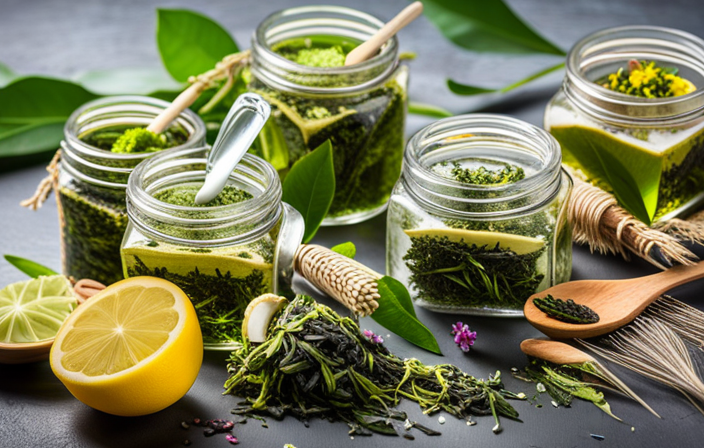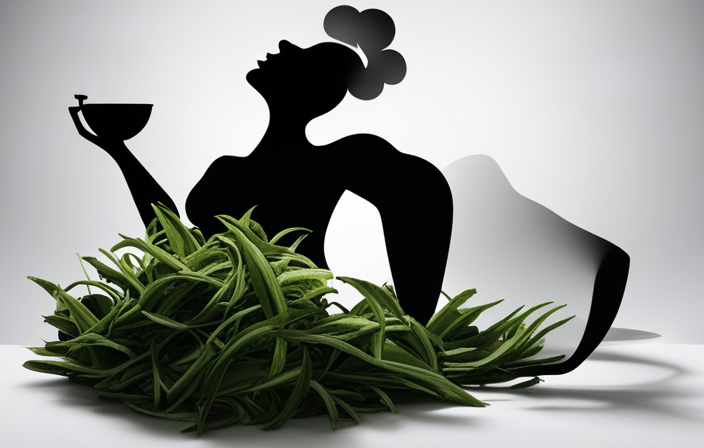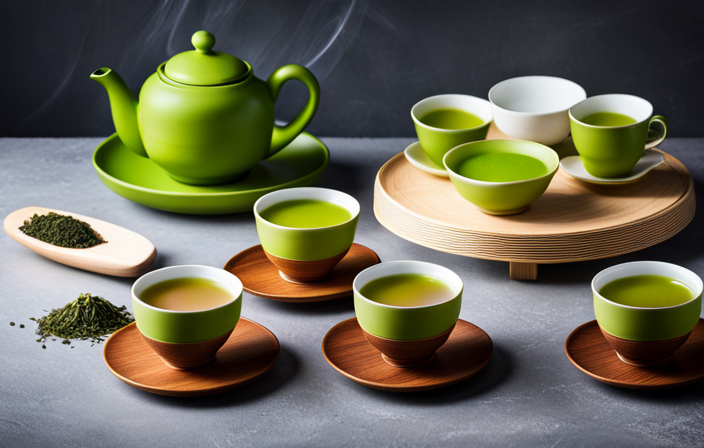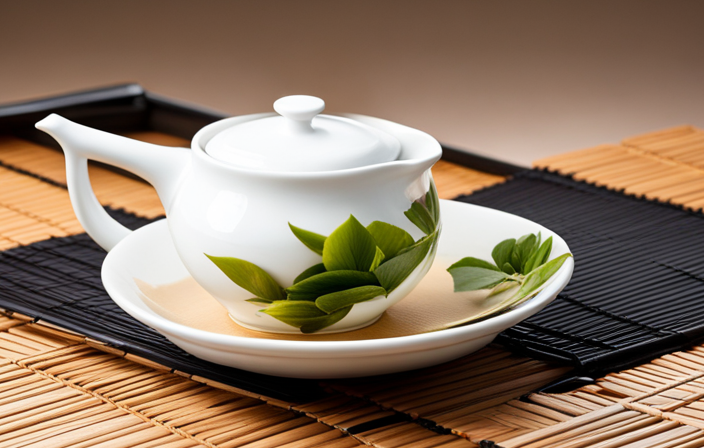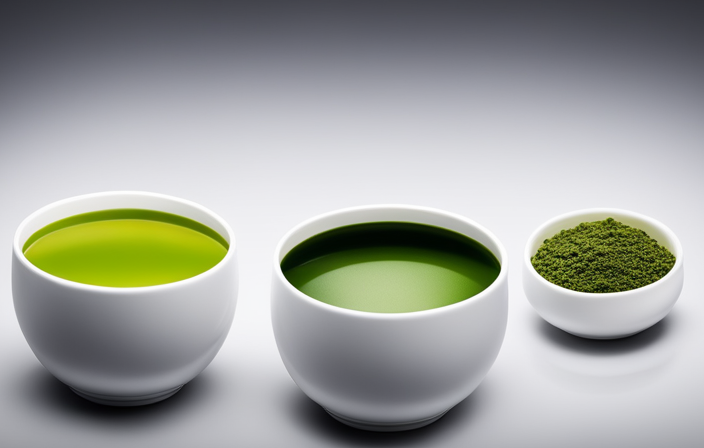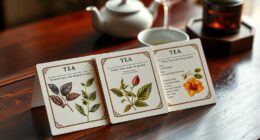As a beauty enthusiast, I’ve discovered a treasure trove of DIY green tea beauty products that are not only effective but also easy to make at home.
These natural concoctions will leave you feeling refreshed, rejuvenated, and ready to take on the world.
From a soothing green tea face mask to a nourishing green tea hair rinse, these homemade remedies are sure to bring out your inner glow.
So, grab your favorite mug and let’s dive into the world of green tea beauty!
Key Takeaways
- Green tea can be used to make a variety of beauty products for the face, body, hair, lips, and feet.
- Green tea provides numerous benefits for the skin, including detoxifying, cleansing, and promoting a healthy complexion.
- Incorporating green tea into your skincare routine can help balance pH levels, reduce inflammation and acne, and unclog pores.
- Green tea is a natural remedy in traditional medicine and is known for its antioxidant properties and ability to promote hair growth and prevent hair loss.
Green Tea Face Mask
I love using a green tea face mask to refresh my skin and give it a natural glow. Green tea isn’t only a delicious beverage, but it also has amazing benefits for our skin.
When used in a face mask, it can help to cleanse and detoxify the skin, leaving it feeling rejuvenated and looking radiant. To make a green tea face mask, simply mix green tea leaves with a few drops of water to form a paste. Apply the mixture to your face, avoiding the eye area, and leave it on for about 15 minutes before rinsing off.
For added benefits, you can also incorporate green tea face cleanser and green tea face serum into your skincare routine. These products can help to further cleanse and nourish your skin, giving you a healthy and glowing complexion.
Green Tea Toner
Using a green tea toner can help to balance the skin’s pH levels and reduce inflammation, giving it a healthier and more refreshed appearance. Green tea is packed with antioxidants and anti-inflammatory properties, making it a great addition to your skincare routine, especially if you’re dealing with acne-prone skin.
Green tea can help to unclog pores, control oil production, and soothe irritated skin. To make a green tea toner at home, simply brew a cup of green tea and let it cool completely. Then, pour the tea into a spray bottle and spritz it onto your face after cleansing. Gently pat it into your skin and follow up with a moisturizer.
Incorporating this simple step into your daily skincare routine can make a significant difference in the overall health and appearance of your skin.
Green Tea Eye Cream
Applying a homemade green tea eye cream can help reduce puffiness and dark circles, giving your under-eye area a brighter and more rejuvenated look. Green tea is rich in antioxidants and caffeine, which can help improve blood circulation, reduce inflammation, and tighten the skin.
To make a simple green tea eye cream, start by brewing a cup of green tea and allowing it to cool. Then, mix it with a teaspoon of aloe vera gel and a few drops of vitamin E oil. Gently pat the mixture onto your under-eye area using your ring finger. The caffeine in green tea can constrict blood vessels, reducing puffiness, while the antioxidants can help prevent wrinkles and reduce dark circles.
Leave the eye cream on overnight for best results.
Green Tea Hair Mask
There are three simple ingredients you can combine to create a nourishing and hydrating green tea hair mask. Green tea isn’t only great for drinking, but it can also promote hair growth and improve the overall health of your hair.
To make this homemade green tea hair mask, you’ll need green tea powder, coconut oil, and honey. Start by brewing a cup of green tea and letting it cool. Then, mix two tablespoons of green tea powder with two tablespoons of coconut oil and one tablespoon of honey.
Apply the mixture to your hair, focusing on the roots and ends. Leave it on for 30 minutes before rinsing it out with warm water.
This green tea hair mask will leave your hair feeling soft, hydrated, and nourished. Give it a try and enjoy the benefits of green tea for your hair!
Green Tea Body Scrub
I love using a green tea body scrub because it exfoliates my skin and leaves it feeling refreshed and rejuvenated. Green tea isn’t only a great beverage, but it also has amazing benefits for our skin.
When used as an exfoliating scrub, green tea helps to remove dead skin cells, unclog pores, and improve skin texture. Making a homemade green tea exfoliating scrub is easy and affordable. Simply mix green tea leaves with some sugar or salt, add a carrier oil like coconut or olive oil, and voila! You have a natural and effective scrub that will leave your skin glowing.
The antioxidants in green tea also help to combat free radicals and reduce inflammation, making it a perfect addition to your skincare routine. So why not give it a try and enjoy the benefits of this homemade green tea beauty product? Your skin will thank you!
Green Tea Bath Soak
I love soaking in a warm bath after a long day. Adding green tea to the mix takes it to a whole new level. Green tea is known for its amazing skin benefits, such as reducing inflammation and fighting acne.
To make a DIY green tea bath soak, simply steep a few green tea bags in hot water, let it cool, and pour it into your bath. It’s a soothing and rejuvenating experience that will leave your skin feeling soft and refreshed.
Skin Benefits of Green Tea
My skin feels refreshed and rejuvenated after using a green tea bath soak. Green tea isn’t only a soothing beverage, but it also offers numerous benefits for our skin.
It’s known for its ability to prevent acne and reduce inflammation, making it a great addition to our skincare routine. Green tea contains antioxidants that help fight acne-causing bacteria and reduce sebum production. It also has anti-inflammatory properties that can calm irritated skin and reduce redness.
Incorporating green tea into our beauty routine can help keep our skin clear and healthy. Now that we understand the benefits of green tea, let’s explore a DIY bath soak recipe that will allow us to enjoy these benefits right at home.
DIY Bath Soak Recipe
How can I make a DIY bath soak recipe using green tea?
-
Start by brewing a strong cup of green tea and letting it cool.
-
In a bowl, mix together Epsom salt, baking soda, and your favorite essential oils.
-
Gradually add the cooled green tea to the mixture, stirring well to combine.
-
Transfer the mixture to a jar or container and let it sit for a few hours to allow the scents to blend together.
Creating your own DIY bath soak recipe using green tea is a simple and enjoyable way to pamper yourself. Green tea is known for its soothing properties and can help to relax and rejuvenate your body and mind. By incorporating it into your bath soak, you can enhance the benefits and create a spa-like experience in the comfort of your own home.
Green Tea Lip Balm
Using green tea lip balm has been incredibly soothing for my dry, chapped lips. Not only does it provide much-needed hydration, but it also offers a refreshing and subtle green tea scent. I love how it glides on smoothly and leaves a glossy finish on my lips. Green tea lip balm is packed with antioxidants that help protect my lips from environmental damage. It’s a great addition to my skincare routine, especially during the winter months when my lips tend to get even drier. To enhance the benefits of green tea, I also incorporate a green tea lip scrub into my routine. This gentle exfoliator removes dead skin cells and leaves my lips feeling soft and smooth. For a pop of color, I finish off with a green tea lip tint, which gives my lips a natural and healthy-looking flush. Overall, green tea-based lip products have become my go-to for achieving soft, nourished, and beautiful lips.
| Product | Benefits | Ingredients |
|---|---|---|
| Green Tea Lip Balm | Hydrates and protects lips | Green tea extract, beeswax, shea butter |
| Green Tea Lip Scrub | Exfoliates and smooths lips | Green tea leaves, sugar, coconut oil |
| Green Tea Lip Tint | Adds a natural flush of color | Green tea extract, jojoba oil, natural pigments |
Green Tea Facial Mist
I love keeping a bottle of green tea facial mist in my skincare routine as it provides a refreshing burst of hydration and helps to revive my tired complexion. Green tea has long been known for its numerous benefits for the skin, and incorporating it into your beauty routine can do wonders for your complexion.
Here are four reasons why you should consider adding a green tea face mist to your skincare arsenal:
-
Hydration: Green tea facial mist is a great way to replenish moisture in your skin, especially during hot summer months or in dry climates.
-
Antioxidant-rich: Green tea is packed with antioxidants that help to protect your skin from environmental damage and reduce signs of aging.
-
Soothing and calming: The natural compounds in green tea have anti-inflammatory properties, making it perfect for soothing irritated or sensitive skin.
-
Refreshing pick-me-up: Spritzing a green tea face mist throughout the day can provide an instant boost of freshness and rejuvenation, leaving you feeling revitalized.
Incorporating a green tea facial mist into your skincare routine is a simple and effective way to give your skin the love it deserves.
Green Tea Hair Rinse
I love using a green tea hair rinse to keep my hair healthy and prevent hair loss. Green tea is packed with antioxidants that promote hair growth and reduce hair fall.
It also helps to soothe the scalp and adds shine to my hair.
Let’s discuss the amazing benefits of green tea for our hair and how we can incorporate it into our beauty routine.
Benefits of Green Tea
Although there are various DIY beauty products you can make at home, it’s important to understand the benefits of green tea, especially when it comes to using it as a hair rinse. Green tea isn’t only a refreshing beverage, but it also offers numerous skin benefits and can help prevent hair loss.
Here are four reasons why green tea is a must-have in your beauty routine:
-
Antioxidant powerhouse: Green tea is rich in antioxidants that help protect the skin from damage caused by free radicals, promoting a youthful and healthy complexion.
-
Soothing properties: The natural compounds in green tea have anti-inflammatory properties, making it an excellent choice for calming irritated skin and soothing scalp conditions.
-
Hair growth stimulant: Green tea contains a compound called EGCG, which has been shown to promote hair growth and prevent hair loss by inhibiting the activity of certain enzymes.
-
Scalp revitalizer: The caffeine in green tea stimulates blood circulation in the scalp, promoting healthy hair growth and preventing dandruff.
Incorporating green tea into your beauty routine can provide a multitude of benefits for your skin and hair. Give it a try and experience the wonders of this natural ingredient!
Preventing Hair Loss
Drinking two cups of green tea a day and using a green tea hair rinse can help prevent hair loss and promote healthy hair growth. Green tea is rich in antioxidants and catechins that help reduce hair fall and strengthen hair follicles. It also contains polyphenols that stimulate hair growth and improve overall hair health. Green tea is a natural remedy for hair loss that has been used for centuries in traditional medicine.
To make a green tea hair rinse, simply steep a green tea bag in hot water for a few minutes, let it cool, and then pour it over your hair after shampooing. Massage it into your scalp for a few minutes and rinse with cold water. This will help nourish your hair, reduce breakage, and add shine.
In addition to drinking green tea and using a hair rinse, it’s important to maintain a healthy diet, exercise regularly, and avoid excessive heat and chemical treatments that can damage your hair. By incorporating green tea into your hair care routine and adopting a healthy lifestyle, you can prevent hair loss and promote healthy hair growth naturally.
Green Tea Foot Soak
My favorite way to pamper myself is by indulging in a relaxing green tea foot soak. Not only does it feel amazing, but it also has numerous benefits for the mind and body.
Here are four reasons why you should try a green tea foot soak:
-
Relaxation: The warm water and soothing scent of green tea can help calm your mind and relieve stress.
-
Detoxification: Green tea is known for its antioxidant properties, which can help remove toxins from your feet and promote overall detoxification.
-
Hydration: Soaking your feet in green tea can help moisturize and hydrate dry, cracked skin, leaving them soft and supple.
-
Improved circulation: The warm water and the presence of caffeine in green tea can help stimulate blood flow, improving circulation in your feet.
Frequently Asked Questions
Can Green Tea Beauty Products Be Used on Sensitive Skin?
Yes, green tea beauty products can be used on sensitive skin. They possess soothing properties that help calm and protect sensitive skin. The best green tea beauty products for sensitive skin provide hydration, reduce redness, and promote a healthy complexion.
How Often Should I Use Green Tea Beauty Products?
I use green tea beauty products regularly to enjoy the benefits it brings to my skincare routine. It’s important to store homemade products properly to maintain their effectiveness and freshness.
Can I Use Green Tea Beauty Products if I Have Allergies?
Can green tea beauty products be used if allergies are present? While some may experience skin sensitivity, green tea has soothing properties that can benefit many. It’s best to patch test first.
Are Green Tea Beauty Products Suitable for All Hair Types?
Green tea beauty products can be suitable for all hair types. They provide numerous benefits like promoting hair growth, reducing dandruff, and adding shine. DIY green tea face masks can also improve the overall health of your hair.
Can Green Tea Beauty Products Help With Acne or Blemishes?
Yes, green tea beauty products can help with acne and blemishes. Green tea has anti-inflammatory properties that can reduce redness and inflammation, making it effective in treating acne. It also contains antioxidants that promote skin hydration and fight signs of aging.
Conclusion
In conclusion, creating your own DIY green tea beauty products at home isn’t only fun and creative, but it also allows you to take advantage of the numerous benefits that green tea has to offer for your skin, hair, and overall beauty routine.
From face masks to toners, eye creams to hair rinses, the possibilities are endless. So, why not give it a try and pamper yourself with these natural and effective green tea remedies?
Your skin and hair will thank you!

